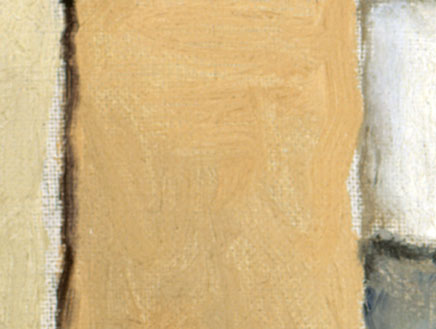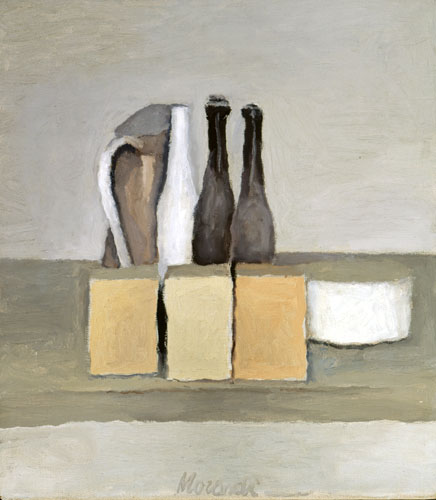Okay … so what do you think this is a painting of?

Boxes? An Arm? a Fence?
Well …it’s ummmm….. like an orangey brownish thing with some…like…ummmm… greyish brown things around it.
Now check it again…this time from about an arm’s length away.

Woah! Sick still life, right? Pasty colors, simple composition, wobbly forms. It makes me wish oil paint wasn’t toxic so I could ingest it sans bodily harm. Right-on, Giorgio Morandi. Thanks for making me think there’s actually objects on a table when there’s actually just yummy paint and colors.
This highlights one of my favorite things about painting in general: in creating a painting, you are creating a context in which people become aware of the process of perception. Painting allows people to get excited about a lounging nude or a bowl of fruit only to step in closer, inspect the surface, and have their illusions dispelled. “I can’t believe it’s just paint on canvas!”
This deconstructive process relates to many of the Dharma teachings about view and perception. “Where there is perception, there is deception” and “from the point of view of absolute reality…all views are wrong views.” We are constantly being fooled by what we think to be real and concrete — we are projecting all kinds of relative meaning and symbolism onto things.
For Giorgio Morandi, 20th Century Italian Painter, this wisdom was revealed to him through a lifetime practice of looking deeply at simple objects on a table and translating the colors and shapes onto canvas. He said towards the end of his life:
“I believe that nothing can be more abstract, more unreal, than what we actually see…matter exists of course, but it has no intrinsic meaning of its own, such as the meaning that we attach to it. Only we can know that a cup is a cup, that a tree is a tree…I have never intended to give the objects in my still-life arrangemnets any particularly familiar meaning.”
His quote reminds me of a term from the Diamond Sutra called Tathagata, which means “the wondrous nature of reality” — when our concepts cease and we see reality for what it really is: “abstract,” “empty,” “signless.”
This teaching was manifest for me in a high school drawing class. I was doing a bad drawing of my friend Corey and my teacher stopped me and said: “Stop trying to draw Corey’s face! If you draw the shapes within Corey’s face, then it will look like Corey.”
Painting and Drawing Rulz. Peace out ’08.
More from Beliefnet and our partners
